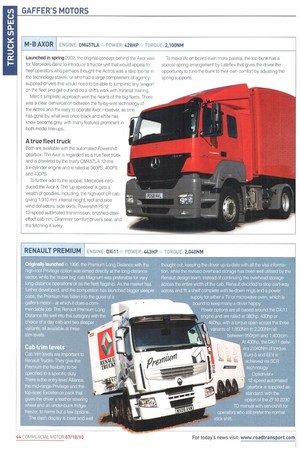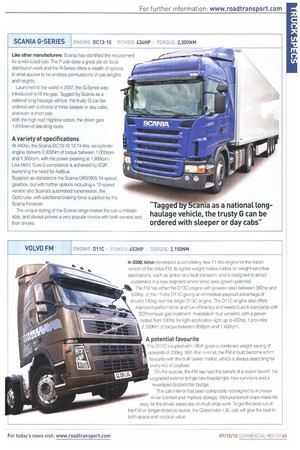Return of the gaffers motor
Page 42

Page 43

Page 44

Page 45

If you've noticed an error in this article please click here to report it so we can fix it.
CM compares the major manufacturers' entry-level gaffer's trucks, which are likely to make up the bulk of any HGV fleet. But which one is right for your operation?
Words: Jack Watters
With money tighter than ever. the 'gaffer's' motor is seeing a new lease of life. In essence it is a basic, no-frills, entry-level spec truck at an entry-level price. Every manufacturer has such trucks in their range, and they arc designed to appeal to the most frugal or cost-conscious of
buyers. These 'dumbed-down' spec trucks are big business for the manufacturers.They form the bulk of their tractor unit registrations, and are typically engaged on distribution and trunking work. In many cases, they will be split-shifted between day and night.
Life on board needs to comfortable without being a gin palace. There needs to be space for enough kit for a day's work, with the bunk more likely to be used to dump kit on than sleep in.
Also, there is no real necessity for high horsepower. The name of this game is low cost and super efficiency. Work on the calculation of 10hphonne on a gross combination weight, and that suggests the buyer should be looking for 440hp on a 44-tonne GCW.
With that in mind, buyers are spoiled for choice. •
IVECO STRALIS AT
Designed as a distribution-based tractor unit. the Stralis AT (Active Time) sides under its larger cabbed brother, the Stralis Active Space3, filing the mantle of long-distance tractor.
The AT is powered by the well-respected Cursor 8 engine, with ratings of 310hp, 330hp or 360hp. and the Cursor 10, with ratings of 420hp or 450hp. It is supplied at Euro-5 using SCR technology, and all engines conform to current EEV standards.
The Stralis is also supplied with the 12-speed Eurotronic AS 2330TD automated gearbox as standard, and the 16-speed ZF as the manual option. At 450hp. the Cursor 10 pushes out 2,100Nm of torque between 1,050rpm and 1.500rpm.
Launched in 2007, the current Stralis benefited from a fair amount of front-end redesign. This included a new grille assembly that has become part of the new Iveco logo and a new headlamp arrangement that looks very impressive. Exterior storage was improved with the introduction of redesigned storage lockers that give access to under the bunks from the outside. Cab aerodynamics are a key priority for all truck manufacturers, and lveco used the opportunity to improve the aerodynamics with the introduction of an aero kit, claiming a marked improvement in fuel consumption. The Stralis AT is available with either standard or high roof, The Stralis AT can be configured as a 4x2 tractor, 6x2 twin-steer and 6x2 tag-axle.
DAF CF85
Seen by many as the Industry standard, the DAF CF85 a well favoured. it is market leader in its sector and with a string of awards to boot, the faithful CF shows no sign of being knocked off its top spot.
OAFS practical approach to truck design, with a simple and a well thought out cab, wins both the hearts and minds of operators and drivers alike. The DAF's designers have carried out a commendable job keeping the CF85 looking fresh, and for those who care to remember the original, the Leyland DAF 85 first saw the light of day In 1992.
A rebrand took place in 2001 and became the DAF 85 CE which coincided with the introduction of Euro-3. This was followed in 2006 by a complete makeover of the cab both inside and out, and another new title, the DAF CF85, with styling very much In line with the flagship XF105.
Powered by DAF's in-house Euro-5 12.9-litre MX engine; outputs are rated at 360hp, 410hp,460hp, and 510hp, and are available as EEV versions.
Both the automated 12-speed AS-Tronic and a 16-speed manual gearbox are available. Inside, the Space Cab option gives a very welcome boost in interior space and additional storage. The 410hp is the volume seller, and as a 6x2 tractor, its very law unladen weight makes the CF85 a very popular choice with payload-conscious operators, particularly in bulk liquid distribution.
MAN TGS
The MAN TGS can be specified with three cab configurations M, L and LX -with the preferred option for trunking being either the L or LX, The LX offers 1,925mm interior height and a full-size bunk at 2,005mm in length.
For operators who want to avoid the use of AdBlue, the 440 is the highest rating available, with all outputs greater than 440 achieving Euro-5 compliancy through SCR. Interestingly, MAN's shrewd marketing department, recognising that the fleet distribution sector offers the largest opportunities and potentially thelargmarket gains, offers Euro-5 with the 02676 engine at 440 with EGR, SCR and EEV.
_ The 12-speed automated Tipmatic gearbox
is supplied as standard, with an optional 16-speed supplied courtesy of ZF. Tipmatic Fleet Is available, which is purely an automatic with no manual settings, therefore eliminating mis-timed, unnecessary changes.
Weight watching
For the weight-conscious and payloadsensitive user, a 6x2 midlift 'lite' option also available running on 285/70R 19.5 wheels and tyres on the mid-lift axle stead of the more usual 295/80R 22,5 size. Ideally suited for use in the petrochemical sector or road tanker application, the MAN TGS fills the void left by the demise of MAN group manufacturer ERF, which dominated the sector up to the very end.
ENGINE 0M457LA POWER: 428HP TORQUE: 2,100NM
Launched in spring 2002, the original concept behind the Axor was for Mercedes-Benz to introduce a tractor unit that would appeal to fleet operators who perhaps thought the Actros was a step too far in the technology stakes, or who had a large complement of agencysupplied drivers that would need to be able to jump into any Wagon' on the fleet and get out and do a sh.ft's work with minimal training.
Merc's simplistic approach won the hearts of the big fleets. There was a clear demarcation between the fly-by-wire technology of the Actros and the easy to operate Axor. However, as time has gone by. what was once black and white has know become grey, with many features prominent in both model hie-ups.
A true fleet truck
Both are available with the automated Powershift gearbox. The Axor is regarded as a true fleet truck and is powered by the trusty 0M457LA 12-litre six-cylinder engine and is rated at 360PS, 400PS and 430PS.
To further add to the appeal, Mercedes introduced the Axor X. The 'up specced' X gets a wealth of goodies, including the high-roof LA cab, giving 1,910 mm internal height; roof and side wind deflectors; side skirts; Powershift PS12 12-speed automated transmission: brushed-steeleffect cab trim; Grammer comfort driver's seat; and the fetching X livery. To make life on board even more palatial, the top bunk has a special spring arrangement by Lateflex that gives the driver the opportunity to tune the bunk to their own comfort by adjusting the spring supports.
RENAULT PREMIUM
ENGINE: 1:1Xi11 POWER: 443HP TORQUE: 2,040NM rovamordra_--rrrz-wegor,
Originally launched in 1996 the Premium Long Distance with the high-roof Privilege option was aimed directly at the long-distance sector, while the 'super big cab Magnum was preferable for very long-distance operations or as the fleet flagship As the market has further developed, and the competition has launched bigger sleeper cabs, the Premium has fallen into the guise of a gaffer 's motor at which it does a commendable iob The Renault Premium Long Distance fits well into this category with the choice of a day cab and two sleeper variants, all available at three trim 'evels
Cab trim levels
Cab trim levels are important to Renault Trucks. They give the Premium the flexibility to be specified to a specific duty. There is the entry-level Alliance, the mid-range Privilege and the top-spec Excellence pack that gives the driver a leather steering wheel and an under-bunk fridgefreezer, to name but a few options.
The dash display is clear and well
thought out, keeping the driver up-to-date with all the vital information, while the revised overhead storage has been well utilised by the Renault design team. instead of continuing the overhead storage across the entire width of the cab, Renault decided to stop part-way across and fit a shelf complete with tie-down rings and a power supply for either a TV or microwave oven which is bound to keep many a driver happy.
Power options are all based around the DXI11 :tengine and are rated at 380hp, 430hp or W. 460hp, with a torque span across the three variants of 1,8CCNm to 2,200Nm all between 950rpm and 1,400rpm At 430hp. the DX111 delivers 2,040Nrn of torque Euro-5 and EEV is achieved via SCR technology.
Optidnver 12-speed automated gearbox is supplied as standard, with the option of the ZF16 2230 TD manual with servoshiff for operators who still prefer the normal
SCANIA G-SERIES
Like other manufacturers, Scania has identified the requirement for a mid-sized cab. The P cab does a great job on local distribution work and the R-Series offers a wealth of options in what appear to be endless permutations of cab lengths and heights.
Launched to the world in 2007, the G-Series was introduced to fill the gap. Tagged by Scania as a national long-haulage vehicle, the trusty 0 can be ordered with a choice of three sleeper or day cabs, and even a short cab.
With the high-roof Highline option, the driver gets 1,910mm of standing room.
A variety of specifications
At 440hp, the Scania 1:1013-10 12.74-litre, six-cylinder engine delivers 2,300Nm of torque between 1,000rpm and 1,300rpm, with the power peaking at 1,900rpm. Like MAN. Euro-5 compliance is achieved by EGR banishing the need for AdBlue.
Supplied as standard is the Scania GRS0905 14-speed gearbox, but with further options including a 12-speed version and ScaniaS automated transmission, the Opticruise, with additional braking force supplied by the Scania Retarder.
The unique styling of the Scania range makes the cab unmistakable, and always proves a very popular choice with both owners and their drivers.
ENGINE D11C 453HP 17)Ptil 2.150NM
In 2008, Volvo developed a completely new 11-litre engine for the tractor version of the Volvo FM. Its lighter weight makes it ideal for weight-sensitive applications, such as tanker and bulk transport, and is designed to attract customers in a new segment where Volvo sees growth potential.
The FM has either the 0130 engine with powers rated between 380hp and 500hp, or the 11-litre 0110 giving an immediate payload advantage of around 140kg over the larger D130 engine. The D110 engine also offers improved performance and fuel efficiency and meets Euro-5 standards with SCR exhaust gas treatment. Available in four versions, with a power output from 330hp for light application right up to 450hp, It provides 2,150Nm of torque between 950rprn and 1,400rom.
A potential favourite
The 0110 coupled with I-Shift gives a combined weight saving of upwards of 200kg. With that in mind, the FM should become a firm favourite with the bulk tanker market, which is always searching for every kilo of payload.
On the outside, the FM has had the benefit of a recent facelift: the upgraded exterior brings new headlamps. new sunvisors and a revamped Globetrotter badge.
The cab interior has been completely redesigned to increase driver comfort and improve storage. Well-positioned steps make life easy for the driver, especially on multi-drop work. To get the best out of the FM on longer-distance routes, the Globetrotter LXL cab will give the best in both space and residual value.




























































































































